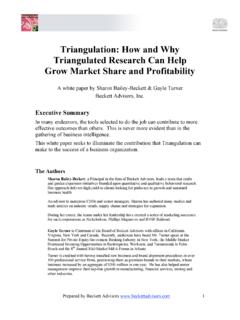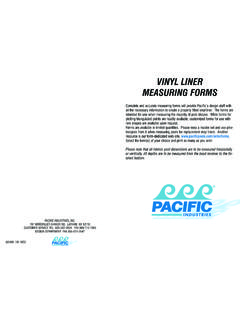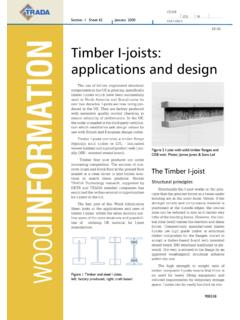Transcription of CALCULATING SURFACE AREA 829 Calculating …
1 Landscape area is almost always presented interms of planimetric area , as if a square kilometer ina mountainous area represents the same amount ofland area as a square kilometer in the of home ranges for wildlife speciesgenerally use planimetric area even when describ-ing mountain goats (Oreamnos americanus) andpumas (Felis concolor). But if a species behaviorand population dynamics are functions of availableresources, and if those resources are spatially limit-ed, I suggest assessing resources using SURFACE areaof the area also is a basis for a useful measure oflandscape topographic roughness.
2 The SURFACE -arearatio of any particular region on the landscape canbe calculated by dividing the SURFACE area of thatregion by the planimetric example,Bowden et al. (2003) found that ratio estimators ofMexican spotted owl (Strix occidentalis lucida)population size were more precise using a versionof this SURFACE - area ratio than with planimetric wildlife species are identified with topo-graphic attributes, including the topographicroughness or ruggedness of the landscape. Forexample, Wakelyn (1987) found greater numbers ofRocky Mountain bighorn sheep (Ovis canadensiscanadensis) in mountain ranges with higher meas-ures of topographic relief, and Gionfriddo andKrausman (1986) found that desert bighorn sheep(O.)
3 C. mexicana) generally were found at or nearCALCULATING SURFACE AREA829 Wildlife Society Bulletin 2004, 32(3):829 839 Peer refereedAuthor's address: United States Department of Agriculture Forest Service, Rocky Mountain Research Station, 2500 S. Pine KnollDrive, Flagstaff, AZ 86001, USA; e-mail: landscape SURFACE areafrom digital elevation modelsJeff S. JennessAbstractThere are many reasons to want to know the true SURFACE area of the landscape, especiallyin landscape analysis and studies of wildlife habitat. SURFACE area provides a better esti-mate of the land area available to an animal than planimetric area , and the ratio of thissurface area to planimetric area provides a useful measure of topographic roughness ofthe landscape.
4 This paper describes a straightforward method of CALCULATING SURFACE -areagrids directly from digital elevation models (DEMs), by generating 8 3-dimensional trian-gles connecting each cell centerpoint with the centerpoints of the 8 surrounding cells,then CALCULATING and summing the area of the portions of each triangle that lay within thecell boundary. This method tended to be slightly less accurate than using TriangulatedIrregular Networks (TINs) to generate SURFACE - area statistics, especially when trying toanalyze areas enclosed by vector-based polygons ( , management units or study areas)when there were few cells within the polygon.
5 Accuracy and precision increased rapid-ly with increasing cell counts, however, and the calculated SURFACE - area value was con-sistently close to the TIN-based area value at cell counts above 250. Raster-based analy-ses offer several advantages that are difficult or impossible to achieve with TINs, includ-ing neighborhood analysis, faster processing speed, and more consistent output. Usefulderivative products such as SURFACE -ratio grids are simple to calculate from SURFACE -areagrids. Finally, raster-formatted digital elevation data are widely and often freely available,whereas TINs must generally be generated by the wordselevation, landscape, SURFACE area , SURFACE ratio, terrain ruggedness, TIN, topographicroughness, rugosity, triangulated irregular networkthe tops of steep slopes and close to steep, rockyescape terrain.
6 Warrick and Cypher (1998) foundthat kit foxes (Vulpes macrotis mutica) nearBakersfield, California were strongly associatedwith low topographic ruggedness, and Wiggers andBeasom (1986) found that Texas white-tailed deer(Odocoileus virginianus texanus) appeared toprefer areas with less topographic ruggedness thandesert mule deer (O. hermionus crooki).A variety of methods exist in the literature formeasuring terrain (1972)described some early computational methods forestimating SURFACE area and discussed the concept ofsurface- area (1983) described amethod for estimating land SURFACE ruggednessbased on the intersections of sample points and con-tour lines on a contour map, and Jenness (2000)described a similar method based on measuring thedensity of contour lines in an area .
7 Mandelbrot(1983:29, 112 115) described the concept of a frac-tal dimension in which the dimension of an irregu-lar SURFACE lies between 2 (representing a flat plain)and 3 (representing a SURFACE that goes throughevery point within a volume). CALCULATING this frac-tal dimension can be very challenging computation-ally, and Polidori et al. (1991), Lam and De Cola(1993), and Lorimer et al. (1994) discussed a varietyof methods for estimating the fractal dimension for alandscape. An estimate of SURFACE area also could bederived from slope and aspect within a cell (Berry2002), although Hodgson (1995) demonstrated howmost slope-aspect algorithms generate values reflect-ing an area 2 times the size of the actual values derived with this method wouldtherefore be unduly influenced by adjacent this paper I demonstrate a straightforwardmethod for CALCULATING the SURFACE area of land-scapes from digital elevation models (DEMs)
8 , whichare widely and freely available within the UnitedStates and are becoming increasingly availablethroughout the rest of the world (Jet PropulsionLaboratory 2003, Gesch et al. 2002, United StatesGeological Survey [USGS] 2002). I compared sur-face- area values produced by this method with val-ues produced with triangulated irregular networks(TINs), which are 3-dimensional vector representa-tions of a landscape created by connecting theDEM elevation values into a continuous DEMs, these TINs are continuous vector sur-faces and therefore can be precisely measured andclipped. I also discuss advantages and disadvan-tages of this method in comparison to using this paper I refer to grids, and inthis case a grid is a specific type of geographic dataused by ArcInfo and ArcView.
9 A grid essentially is araster image in which each pixel is referred to as a cell and has a particular value associated with USGS DEMs, the cell value reflects the elevationin meters of the central point in that method described here derives surfaceareas for a cell using elevation information fromthat cell plus the 8 adjacent cells. For example,given a sample elevation grid, this method wouldcalculate the SURFACE area for the cell with eleva-tion value 165 based on the elevation values ofthat cell plus the 8 surrounding cells (Figure 1).That central cell and its surrounding cells are pic-tured in 3-dimensional space as a set of adjacentcolumns, each rising as high as its specified eleva-tion value (Figure 2b).
10 The 3-dimensional centerpoints of each of these9 cells are used to calculate the Euclidian distancebetween the focal cell s centerpoint and the cen-terpoints of each of the 8 surrounding cells. I usethe term SURFACE length to highlight the 3-dimen-sional character of this line; this is not the plani-metric (horizontal) distance between cell center-points. Next, calculate the SURFACE lengths of thelines that connect each of the 8 surrounding cellswith the ones adjacent to it to get the lengths of thesides of the 8 triangles projected in 3-dimensionalspace that all meet at the centerpoint of the centralcell (Figure 3b).









